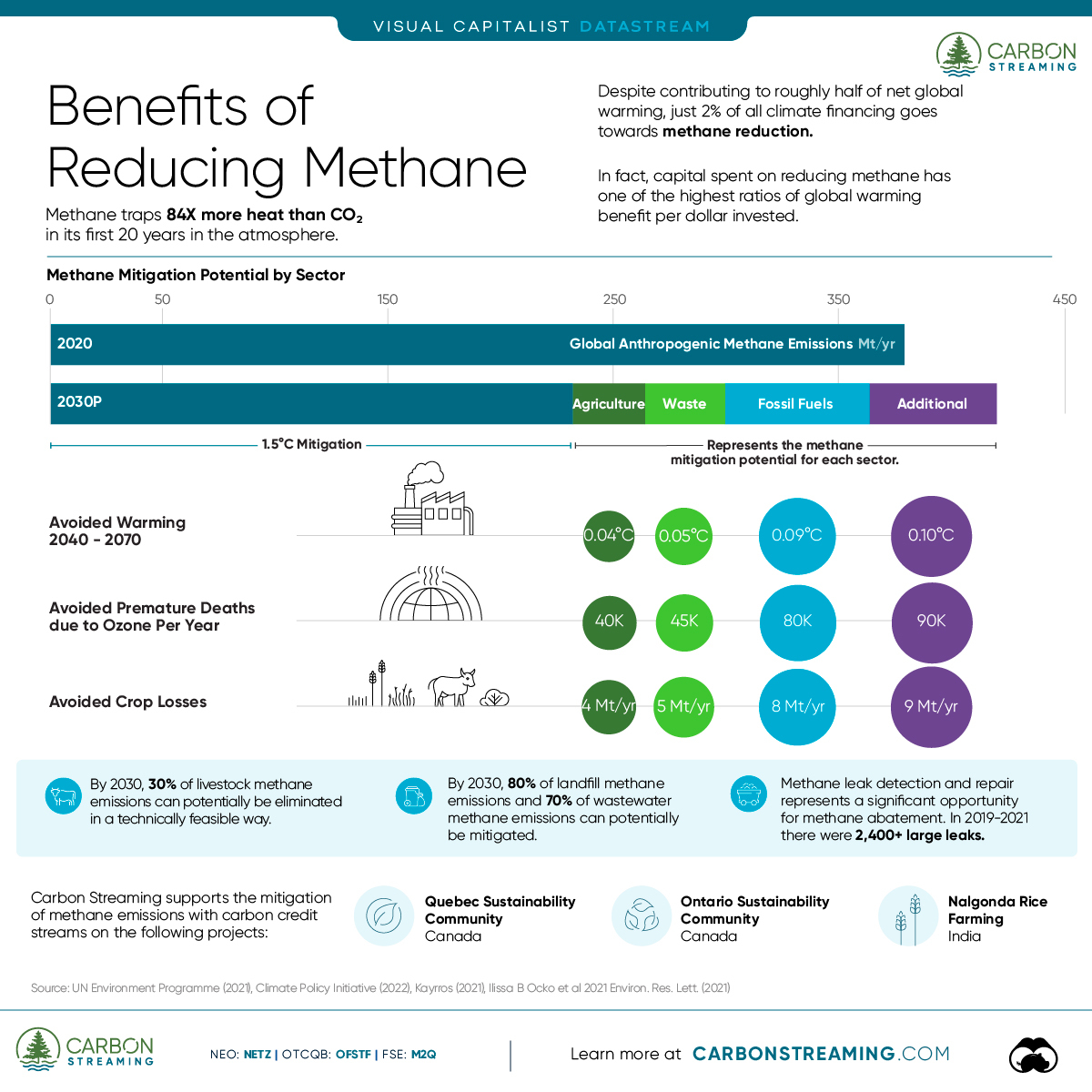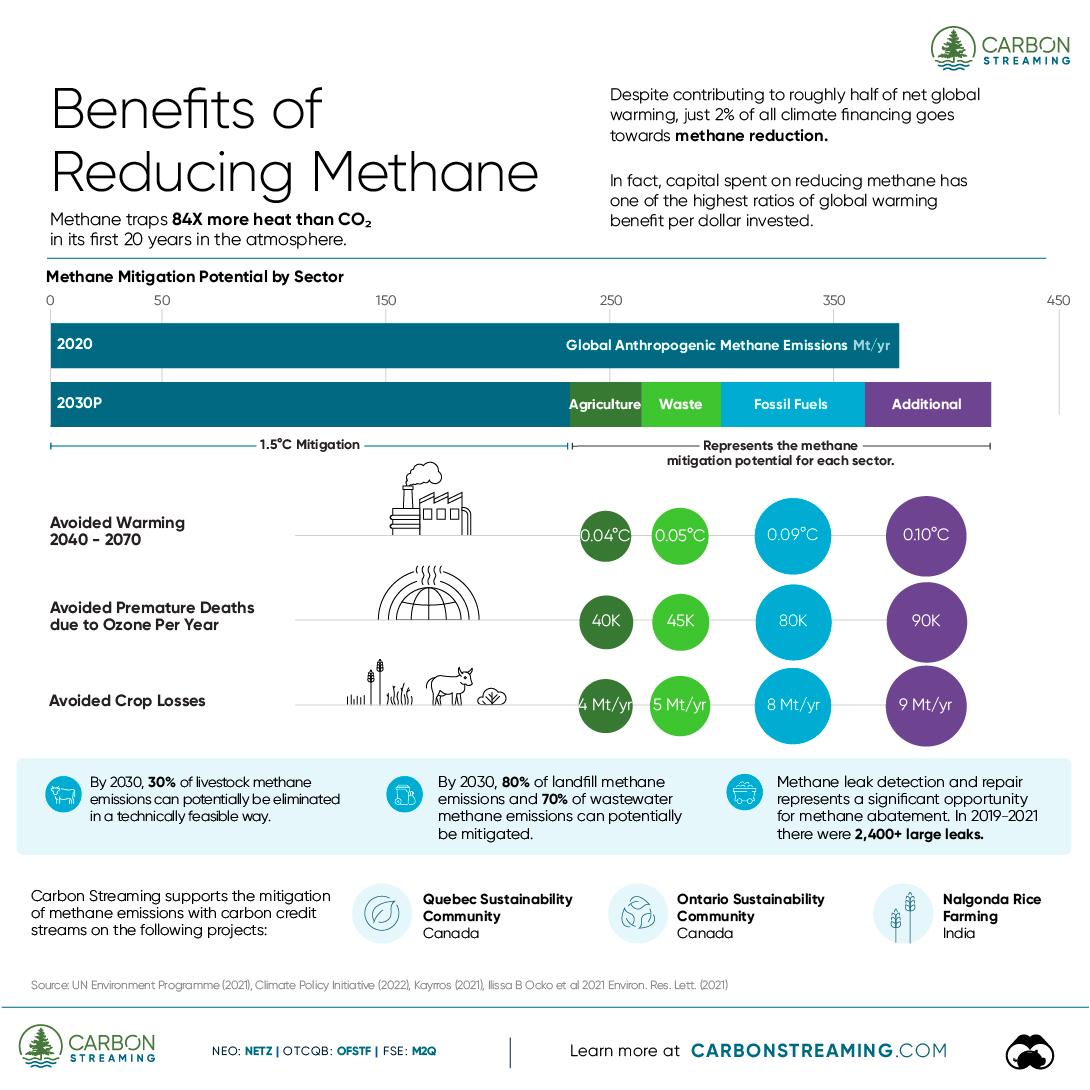Datastream
The Benefits of Reducing Methane Emissions
The following content is sponsored by Carbon Streaming Corporation.

The Briefing
- Almost half of net global warming comes from methane emissions—but only 2% of all climate financing goes towards its reduction.
- By 2030, 45% of anthropogenic methane emissions can be reduced with available, targeted solutions combined with additional measures that are aligned with development goals.
The Benefits of Reducing Methane Emissions
Methane is highly potent, capturing 84 times more heat than CO₂ in its first 20 years in the atmosphere.
In spite of these dangers, methane abatement receives a fraction of all climate financing. Based on an analysis from the Climate Policy Initiative, $110 billion in funding is needed annually, or about tenfold the amount spent today.
This infographic sponsored by Carbon Streaming Corporation looks at the benefits of mitigating methane emissions across key sectors.
The Benefits of Reducing Methane Emissions
The risk of methane emissions is substantial: it has contributed to nearly half of net global warming.
The good news is that future emissions can be cut significantly. Methane solutions that are currently available, combined with additional measures that target priority development goals, can cut 45% of human-caused methane emissions by 2030, equivalent to about 180 million tonnes per year (Mt/yr).
This translates into 0.28°C in avoided warming between 2040 and 2070 along with 255,000 premature deaths being avoided due to rising ozone concentrations.
| Sector | Avoided Warming 2040 - 2070 | Avoided Premature Deaths due to Ozone Per Year | Avoided Crop Losses |
|---|---|---|---|
| Agriculture | 0.04°C | 40,000 | 4 Mt/yr |
| Waste | 0.05°C | 45,000 | 5 Mt/yr |
| Fossil Fuels | 0.09°C | 80,000 | 8 Mt/yr |
| Additional | 0.10°C | 90,000 | 9 Mt/yr |
| Total | 0.28°C | 255,000 | 26 Mt/yr |
Source: UN Environment Programme
On top of this, 26 million tonnes of crop losses could be avoided each year—equal to about 10% of America’s total food production annually—by utilizing these combined reduction measures.
Methane Mitigation Potential by Sector
As a noxious greenhouse gas, methane is often found in livestock emissions, landfills, and natural gas. For these reasons, the agricultural, waste, and fossil fuel sectors produce the most methane emissions annually.
Where do the largest opportunities lie in mitigating emissions?
Waste
The waste sector presents an opportunity to reduce 29-36 million tonnes of methane emissions annually. The vast majority—80% of landfill emissions and 70% of wastewater methane emissions—can potentially be mitigated by 2030 with technologies that are technically feasible today.
Agriculture
By 2030, 30 million tonnes of methane emissions have the potential to be removed each year in the agricultural sector. In fact, 30% of livestock emissions can be potentially eliminated in a technically feasible way over this time period.
Fossil Fuels
The highest potential is found in fossil fuels, with up to 57 million tonnes of methane emissions from the oil and gas sector and up to 25 million tonnes from the coal sector having the potential to be mitigated each year by 2030. Research shows that up to 80% of targeted measures in the oil and gas sector and up to 98% of coal measures could be implemented at negative or low cost.
In particular, methane leak detection and repair in the oil and gas industry represent a significant opportunity. For instance, between 2019 and 2021, over 2,400 large methane leaks took place.
Significant Potential
Today, technologies to fight methane emissions are readily available, with the potential for immediate benefits.
Consider how 0.1°C in warming could be prevented by 2050 using methane abatement technologies in the oil and gas sector. This is equivalent to eliminating the entire emissions of road vehicles—from cars to two-wheelers—globally.
Given the grave threat methane emissions pose to the planet and society, methane abatement solutions present significant opportunities using current technologies.
Carbon Streaming supports mitigating methane emissions with its carbon credit streams on projects in Canada and India.
Where does this data come from?
Source: UN Environment Programme, ‘Global Methane Assessment: Benefits and Costs of Mitigating Methane Emissions’ (May 2021)
Datastream
Can You Calculate Your Daily Carbon Footprint?
Discover how the average person’s carbon footprint impacts the environment and learn how carbon credits can offset your carbon footprint.

The Briefing
- A person’s carbon footprint is substantial, with activities such as food consumption creating as much as 4,500 g of CO₂ emissions daily.
- By purchasing carbon credits from Carbon Streaming Corporation, you can offset your own emissions and fund positive climate action.
Your Everyday Carbon Footprint
While many large businesses and countries have committed to net-zero goals, it is essential to acknowledge that your everyday activities also contribute to global emissions.
In this graphic, sponsored by Carbon Streaming Corporation, we will explore how the choices we make and the products we use have a profound impact on our carbon footprint.
Carbon Emissions by Activity
Here are some of the daily activities and products of the average person and their carbon footprint, according to Clever Carbon.
| Household Activities & Products | CO2 Emissions (g) |
|---|---|
| 💡 Standard Light Bulb (100 watts, four hours) | 172 g |
| 📱 Mobile Phone Use (195 minutes per day)* | 189 g |
| 👕 Washing Machine (0.63 kWh) | 275 g |
| 🔥 Electric Oven (1.56 kWh) | 675 g |
| ♨️ Tumble Dryer (2.5 kWh) | 1,000 g |
| 🧻 Toilet Roll (2 ply) | 1,300 g |
| 🚿 Hot Shower (10 mins) | 2,000 g |
| 🚙 Daily Commute (one hour, by car) | 3,360 g |
| 🍽️ Average Daily Food Consumption (three meals of 600 calories) | 4,500 g |
| *Phone use based on yearly use of 69kg per the source, Reboxed | |
Your choice of transportation plays a crucial role in determining your carbon footprint. For instance, a 15 km daily commute to work on public transport generates an average of 1,464 g of CO₂ emissions. Compared to 3,360 g—twice the volume for a journey the same length by car.
By opting for more sustainable modes of transport, such as cycling, walking, or public transportation, you can significantly reduce your carbon footprint.
Addressing Your Carbon Footprint
One way to compensate for your emissions is by purchasing high-quality carbon credits.
Carbon credits are used to help fund projects that avoid, reduce or remove CO₂ emissions. This includes nature-based solutions such as reforestation and improved forest management, or technology-based solutions such as the production of biochar and carbon capture and storage (CCS).
While carbon credits offer a potential solution for individuals to help reduce global emissions, public awareness remains a significant challenge. A BCG-Patch survey revealed that only 34% of U.S. consumers are familiar with carbon credits, and only 3% have purchased them in the past.
About Carbon Streaming
By financing the creation or expansion of carbon projects, Carbon Streaming Corporation secures the rights to future carbon credits generated by these sustainable projects. You can then purchase these carbon credits to help fund climate solutions around the world and compensate for your own emissions.
Ready to get involved?
>> Learn more about purchasing carbon credits at Carbon Streaming
-

 Mining1 week ago
Mining1 week agoGold vs. S&P 500: Which Has Grown More Over Five Years?
-

 Markets2 weeks ago
Markets2 weeks agoRanked: The Most Valuable Housing Markets in America
-

 Money2 weeks ago
Money2 weeks agoWhich States Have the Highest Minimum Wage in America?
-

 AI2 weeks ago
AI2 weeks agoRanked: Semiconductor Companies by Industry Revenue Share
-

 Markets2 weeks ago
Markets2 weeks agoRanked: The World’s Top Flight Routes, by Revenue
-

 Countries2 weeks ago
Countries2 weeks agoPopulation Projections: The World’s 6 Largest Countries in 2075
-

 Markets2 weeks ago
Markets2 weeks agoThe Top 10 States by Real GDP Growth in 2023
-

 Demographics2 weeks ago
Demographics2 weeks agoThe Smallest Gender Wage Gaps in OECD Countries










